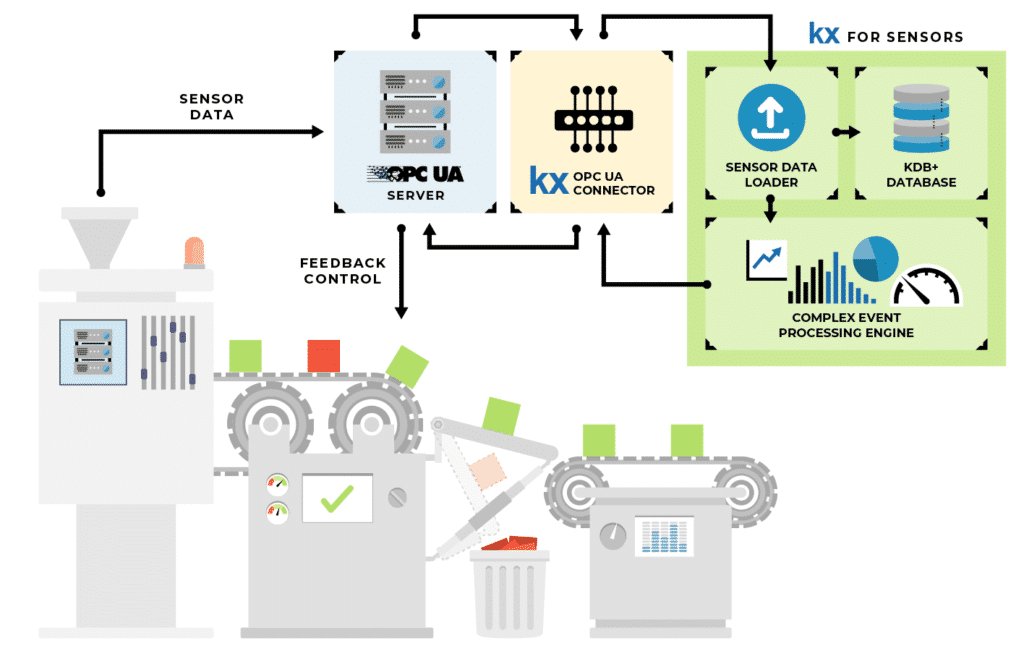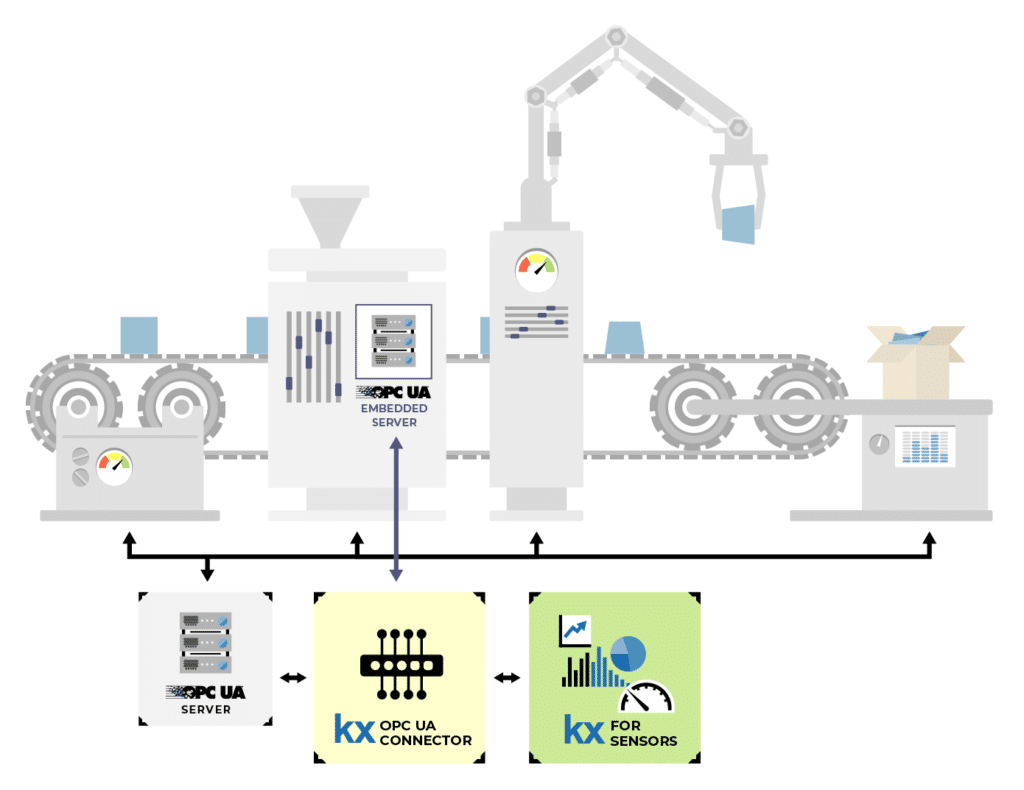By Nelson Andre
The ability to store and monitor large volumes of manufacturing data is critical in the rapidly evolving field of Industrial IoT. Open Platform Communications Unified Architecture (OPC UA) has emerged as a standard communication protocol for enabling the connectivity and communication of a wide variety of diverse industrial automation devices and systems. The KX OPC UA Connector empowers systems to stream sensor data at high frequencies and volumes from OPC UA directly into KX for Sensor’s kdb+ time-series database. This allows for efficient data usage enabling immediate response to equipment and sensor conditions.
The KX for Sensors platform is designed specifically for the efficient storage, retrieval, and processing of large volumes of sensor data using the kdb+ database. This enables users to rapidly visualize and perform calculations on the data to detect anomalies and make predictions. Because of its ability to efficiently recall historical data, combined with streaming data, KX for Sensors empowers users to train and utilize machine learning models that can predict failures in the plant.
The major benefits provided by building a connected plant that is powered by KX for Sensors using OPC UA include:
- Identifying inefficiencies in the plant
- Improving visibility across operations
- Optimizing line and product yield
- Enabling preventative actions to reduce plant downtime
- Reducing waste
Use Case
One example of integrating KX for Sensors with OPC UA involves a manufacturer wanting to capture and monitor sensor data from their injection molding processes, for use in making decisions on that data to identify product deficiencies.

Real-time Decisions and Device Control
Injection molding of thermoplastics involves a process where the plastic material is injected into a mold cavity. The process relies on precise moderation of pressure and temperature to ensure a product that meets quality specifications. Patterns, trends, and deviations in sensor data signals can be identified with pre-trained machine learning models that indicate when the process has resulted in a bad batch of products.
KX for Sensors was able to subscribe to the sensor data relating to the injection molding machine using the KX OPC Connector, and then rapidly process and analyze all of the sensor data that was associated with a single product. This amounted to thousands of data points every ten seconds. Leveraging the data collected, machine learning models were applied to determine (within 100 milliseconds) if a product met strict specifications. A feedback signal was sent back to the molding machine to control whether the product was binned (i.e. scrapped) or was to continue through the manufacturing pipeline.
OPC UA with KX for Sensors
KX for Sensors is a highly flexible and extensible platform that can analyze and securely store large volumes of sensor data on-premises or in the cloud using the kdb+ database, integrating with existing systems as required. It is uniquely able to perform complex analytics in real time that can power interactive visualizations, giving you a comprehensive view of your plant’s operations. This allows for immediate and automated decisions to optimize the manufacturing process.

KX for Sensors Interacting With Industrial Devices
The OPC UA communication protocol allows for the translation of incoming data from industrial devices into a standard and open format which, in turn, drives connectivity and automation within a plant. In the use case above, data from sensors on the manufacturer’s equipment was transmitted via the KX OPC UA Connector to the KX for Sensors kdb+ database. The KX OPC UA Connector works with any commercially available OPC UA Server, whether stand-alone, embedded in machinery, or one that is included in a Manufacturing Execution System.
We first start by interrogating the OPC UA Server to identify sensors and methods that are available and to notify KX for Sensors about each sensor and measurement property. We then have the OPC UA Connector subscribe to the data feed from each sensor and send the data to KX for Sensors. OPC UA also supports sending commands to the industrial devices, which often trigger physical machine responses.
KX for Sensors is able to receive data from these devices and using its complex event processing (CEP) engine, it is able to use the KX OPC Connector to issue commands. Examples of this could include the movement of a robotic arm, modifying the temperature of a solution, adjusting the speed of a motor, or selecting the target of a binning gate. With this type of capability, KX for Sensors can be used as a process control system.
The data ingested by KX for Sensors is saved in an in-memory and on-disk historical database and thus made immediately available for retrieval, analysis, and visualization. This helps plant operators diagnose issues, evaluate trends and performance, and make predictions based on past performance.
Conclusion
For manufacturing plants that are looking for high volume and low latency solutions in the fast-growing Industrial IoT environment, it is critical to have a scalable solution that can collect, process, analyze and store the data in real time and make historical data available for reporting, analysis, and predictions.
With the KX OPC UA Connector, manufacturing plants can take advantage of the OPC UA’s open connectivity and communication platform combined with KX’s kdb+, the world’s fastest time-series database, by utilizing the KX for Sensors platform to scale, connect and analyze all plant data in real time together with historical data, improving yields and reducing plant downtime.





